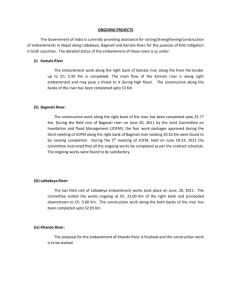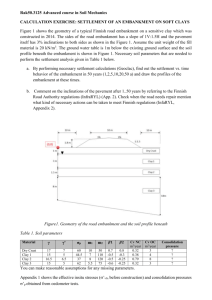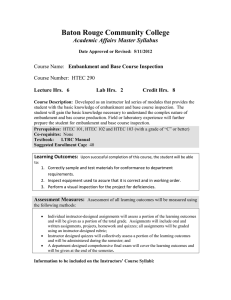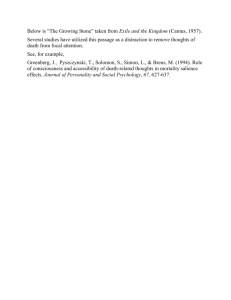SOIL-STRUCTURE INTERACTION: CAPACITY CURVE EVALUATION AND SEISMIC ASSESSMENT OF HIGHWAY OVERCROSSINGS
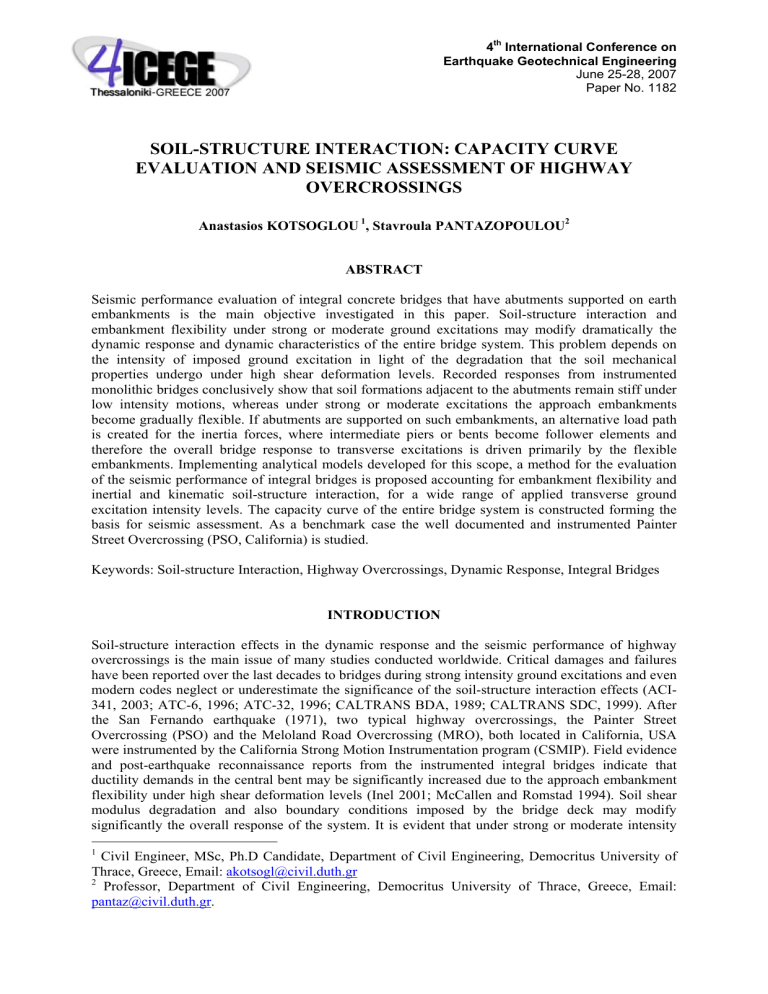
4 th
International Conference on
Earthquake Geotechnical Engineering
June 25-28, 2007
Paper No. 1182
SOIL-STRUCTURE INTERACTION: CAPACITY CURVE
EVALUATION AND SEISMIC ASSESSMENT OF HIGHWAY
OVERCROSSINGS
Anastasios KOTSOGLOU 1 , Stavroula PANTAZOPOULOU 2
ABSTRACT
Seismic performance evaluation of integral concrete bridges that have abutments supported on earth embankments is the main objective investigated in this paper. Soil-structure interaction and embankment flexibility under strong or moderate ground excitations may modify dramatically the dynamic response and dynamic characteristics of the entire bridge system. This problem depends on the intensity of imposed ground excitation in light of the degradation that the soil mechanical properties undergo under high shear deformation levels. Recorded responses from instrumented monolithic bridges conclusively show that soil formations adjacent to the abutments remain stiff under low intensity motions, whereas under strong or moderate excitations the approach embankments become gradually flexible. If abutments are supported on such embankments, an alternative load path is created for the inertia forces, where intermediate piers or bents become follower elements and therefore the overall bridge response to transverse excitations is driven primarily by the flexible embankments. Implementing analytical models developed for this scope, a method for the evaluation of the seismic performance of integral bridges is proposed accounting for embankment flexibility and inertial and kinematic soil-structure interaction, for a wide range of applied transverse ground excitation intensity levels. The capacity curve of the entire bridge system is constructed forming the basis for seismic assessment. As a benchmark case the well documented and instrumented Painter
Street Overcrossing (PSO, California) is studied.
Keywords: Soil-structure Interaction, Highway Overcrossings, Dynamic Response, Integral Bridges
INTRODUCTION
Soil-structure interaction effects in the dynamic response and the seismic performance of highway overcrossings is the main issue of many studies conducted worldwide. Critical damages and failures have been reported over the last decades to bridges during strong intensity ground excitations and even modern codes neglect or underestimate the significance of the soil-structure interaction effects (ACI-
341, 2003; ATC-6, 1996; ATC-32, 1996; CALTRANS BDA, 1989; CALTRANS SDC, 1999). After the San Fernando earthquake (1971), two typical highway overcrossings, the Painter Street
Overcrossing (PSO) and the Meloland Road Overcrossing (MRO), both located in California, USA were instrumented by the California Strong Motion Instrumentation program (CSMIP). Field evidence and post-earthquake reconnaissance reports from the instrumented integral bridges indicate that ductility demands in the central bent may be significantly increased due to the approach embankment flexibility under high shear deformation levels (Inel 2001; McCallen and Romstad 1994). Soil shear modulus degradation and also boundary conditions imposed by the bridge deck may modify significantly the overall response of the system. It is evident that under strong or moderate intensity
1 Civil Engineer, MSc, Ph.D Candidate, Department of Civil Engineering, Democritus University of
2
Thrace, Greece, Email: akotsogl@civil.duth.gr
Professor, Department of Civil Engineering, Democritus University of Thrace, Greece, Email: pantaz@civil.duth.gr
.
ground excitations the seismic performance of bridges supported on earth embankments (Figure 1) may be modified due to the gradually increased embankment compliance. Values of effective or critical embankment length are often used in order to quantify the embankment soil mobilization.
Therefore seismic design of highway overcrossings must be adjusted to the intensity level of the imposed ground excitation.
Figure 1. Typical highway overcrossing assembly
Wilson and Tan (Wilson and Tan 1990a,b) developed the first simple one dimensional model to account for the flexible embankment contribution to the dynamic response of the entire bridge system.
Using the shear wedge concept (Gazetas 1987) and conducting elastic analyses they determined the transverse equivalent stiffness of a unit width wedge under static loads applied at the top. The total transverse stiffness is calculated by multiplying the unit width wedge stiffness with the effective length which is suggested empirically to be equal to the wingwalls length.
Wissawapaisal (Wissawapaisal 1999) suggested two simplified models (soil-pile and soil-slice) based on the shear wedge concept in order to evaluate the dynamic response of highway overcrossings accounting for the embankment compliance. Using inelastic constitutive laws for the soil and through calibration of computed with recorded responses, values of effective embankment length L eff were determined quantifying the embankment contribution to the entire system. Wissawapaisal’s “soilslice” model was extended to skew bridges by Inel (Inel 2001; Inel and Aschheim 2004). An equivalent single degree of freedom system (ESDOF) formulation was proposed for estimating column displacement demands based on capacity curves for the embankment fills and substructure bents.
Zhang and Makris (Zhang and Makris 2002a,b,c), conducted equivalent elastic analyses and proposed a simplified method for the estimation of the kinematic response functions and dynamic stiffnesses of approach embankments. From equivalent linear analysis and 2D plane strain idealization, the dynamic response of approach embankments under transverse or longitudinal excitations was calculated and a closed form expression for critical length L c
was derived. The dynamic response of the entire system
(bridge-embankments-foundation) was evaluated using substructuring techniques.
Kotsoglou and Pantazopoulou (2006a,b,c), developed a two dimensional (2-D) analytical model for the embankment and conducted equivalent elastic analysis to evaluate the dynamic response of short integral concrete bridges under strong intensity ground excitations accounting for soil-structure inertial and kinematic interaction and also for the embankment flexibility under high shear deformation levels.
Explicit methods for the estimation of the critical embankment length were proposed and provided results were calibrated successfully with finite element analyses and recorded responses.
A general procedure that allows for the evaluation of the dynamic response and the seismic assessment of integral bridges with abutments supported on earth embankments under a wide range of load intensities is the main objective of the present work. Clearly, the dynamic response of the entire system is strongly dependent on the embankment mobilization during strong intensity ground excitations. Using the 2-D embankment model previously developed (Kotsoglou and Pantazopoulou
2006a,b,c), general procedures are suggested for the evaluation of the dynamic response of the entire
system under low, moderate or strong intensity ground excitations. Implementation of the proposed method allows for the evaluation of the capacity curve of the entire bridge system accounting for kinematic and inertial soil-structure interaction and embankment flexibility with excellent results.
Seismic demands of the central bent columns may be evaluated and seismic assessment of the entire system may be implemented using “Acceleration-Displacement Response Spectra (A.D.R.S)” in conjunction with the constructed Capacity curve of the overall system.
APPROACH EMBANKMENT STUDY
Dynamic response of approach embankments may be evaluated with accuracy using a 2-D model of the dynamic response of the embankment fill (Kotsoglou and Pantazopoulou 2006a,b,c). The model is derived from first principles, based on equilibrium of forces that act on an infinitesimal rectangular soil segment (Figure 2). Horizontal displacements are assumed uniform only across the embankment u = f ( y , z ) . Considering an infinitesimal embankment segment of height and depth ∆ y , and denoting as ρ the soil density, Q ( y , z )
∆ z , width B ( z ) = B
the shear stress acting on plane c
=const.
X-Z , and u base
the shear stress acting on plane X-Y , the differential equation of motion may be written:
− ρ ⋅ u && + d dz
G ( z ) ⋅ du dz
+ d dy
G ( z ) ⋅ du dy
= 0 (1) where ) is the shear modulus as a function of depth z .
Equation (1) is the general differential equation of motion of the approach embankment. Seismic response of the embankment may be described explicitly by incorporating appropriate boundary conditions and constitutive laws. Detailed solutions of the differential equation of motion (1) are provided elsewhere (Kotsoglou and Pantazopoulou 2006a,b,c).
Figure 2. Modeling of the approach embankment cross section and infinitesimal soil segment
Embankment Response Evaluation - Soil-Structure Interaction
Interaction with the bridge deck is modeled using the assembly of Figure 3. Lumped masses and springs are attached at the edge to account for inertial and kinematic contribution of the bridge deck to the embankment response at the common abutment-embankment D.O.F. The mathematical model (Eq.
1) is supplemented by appropriate boundary conditions and realistic constitutive laws for the soil material so as to reflect the nonlinear dependence of soil compliance with the level of shear deformation.
Boundary Conditions and Soil Constitutive Relationships Selection
Selection of appropriate boundary conditions and realistic material constitutive laws for the soil are of great importance in order to provide reliable estimations of the bridge dynamic response. Regarding the selection of boundary conditions, some general assumptions are made, although in practical applications a case by case evaluation would be pertinent. Considering that there is a critical
embankment length L c
where soil-structure effects are significant, it is assumed that at a distance y = L c
, the variation of relative displacements along the y axis are approximately equal to zero
(Equation 2a) whereas at a long distance, horizontal displacements are independent of y (Equation 2b).
Additionally, equilibrium of acting forces is established at the contact point between the supporting embankment and the abutment (Equation 2c). y ≥ L c
,
∂ u (
∂ z y
, y )
≈ 0 (2a) y ≥ L c
, u ( z , y ) ≈ u ( z ) (2b) y = 0 , Σ F = 0 (2c)
With these boundary conditions Equation 1 is solved to provide explicit expressions for the soil deformation profile. Depending on the soil properties and the lumped mass and spring stiffness values, the distribution of transverse displacements may vary as either an exponential, linear or trigonometric function.
Figure 3. Embankment model accounting for soil-structure inertial and kinematic interaction
Equivalent elastic analysis is performed for simplicity, where soil shear modulus degradation is strongly dependent on the imposed shear strain level. Standard procedures are implemented using viscoelastic material properties for the soil, based on a bundle of decaying curves for G / G max
and modal damping ξ as a function of shear strain γ (Seed and Idriss 1970), where G max
the initial soil shear modulus (i.e. the G value associated with low shear strain, Figure 4).
Figure 4. Normalized soil shear modulus and modal damping versus shear strain curves
Values for G max
may be determined using several alternative methods. The most reliable (Kramer
1996) requires evaluation of the shear wave velocity V s
using standard procedures (Equation 3).
G max
= ρ ⋅ V s
2
(3)
According to the literature, large discrepancies are observed regarding the measurement and selection of appropriate shear wave velocity or soil density values (Price 1997). Therefore, because of the significant uncertainties associated with both the seismic excitation, and the accuracy of the idealization used as a basis of the model, analysis, approximate average values are adopted in this study for soil material. With no loss of generality, embankment geometry and material properties used in the present work are based on those of the PSO bridge (Table 1).
Table 1. PSO Geometry and Material Properties
PSO Embankment Properties PSO Deck Properties
Crest Width B c
Total Height H tot
Slope S
(Vertical:Horizontal)
Soil density
ρ s
15 .
2 m
9 .
6 m
1
2
1600 Kgr / m 3
Concrete Unit Weight
γ c
Modulus of Elasticity E c
Cross Section Area A deck
Total Length L deck
2 .
36 ⋅ 10
− 5
N / mm
3
26 .
2 GPa
7 .
9 ⋅ 10
6 mm
2
81 m
Shear wave Velocity
Plasticity Index P .
I .
V s
( )
195 m / sec Central Bent Soil Foundation Properties
5 − 10 Shear Modulus G max
Soil Density
ρ s 2
100 MPa
1920 kgr / m 3
DYNAMIC RESPONSE
In order to provide a general procedure that allows for evaluation of the dynamic response of short integral concrete bridges, the model developed by Kotsoglou and Pantazopoulou (2006a,b,c) for transverse ground excitations is used for a wide range of loading intensities. As a benchmark case, the seismic performance of the instrumented PSO is evaluated. The PSO is a well documented highway overcrossing that has abutments supported on earth embankments monolithically connected to the deck. It is a two span prestressed concrete box-girder bridge having two spans of 44.5 and 36.3 meters and supported on end abutments and a two column central bent (located in Rio Dell, California). Both abutments and the central bent rest on driven concrete friction piles and are skewed at an angle of 39 degrees measured from the transverse direction. The bridge was instrumented as part of the California
Strong Motion Instrumentation Program (CSMIP) in 1977. Geometry and material parameters of the approach embankment are mentioned in many research reports (Table 1).
Dynamic response of the embankment model (Figure 3) is evaluated from an ESDOF approximation based on the differential equation of motion (Equation 1). Embankment mobilization is described by:
Y && ( t )
− G
⋅
L H
∫ ∫
0 0
⋅ Y ( t )
ρ
⋅
⋅ Φ 2
( z ,
L H
∫ ∫
0 0
Φ ( z , y ) y )
⋅
⋅ dz ⋅ dy dy
2
− G d
2 Φ ( z , y )
⋅ Y ( t )
⋅ dz ⋅
⋅ dy
L H
∫ ∫
0 0
=
Φ ( z ,
− u && g
⋅ y ) ⋅
L H
∫ ∫
0 0 d
2 Φ ( z ,
ρ ⋅ dz
2
Φ ( z , y ) y )
⋅
⋅ dz dz
⋅ dy
⋅ dy
−
(4) where Y && ( t )
(Figure 5),
the generalized SDOF coordinate,
Φ ( z , y )
L is equal to the embankment critical length
is the evaluated deformation shape of the embankment and u g
( t )
L c
the imposed ground displacements. A uniform representative average value of soil shear modulus G is used, depending on the shear strains imposed (Figure 4). Trial and error procedures are necessary to be conducted in order to evaluate converged shear strains and consistent shear modulus and damping values (Gazetas, 1987; Zhang and Makris, 2002). The critical embankment length L c
is evaluated
conducting appropriate sensitivity studies. With respect to Equation (1), eigenfrequencies are calculated for a wide range of critical length L c
values and the diagram Eigenfrequency versus
Critical length is plotted. Recognizing that at distances greater than L c
, the embankment response is insensitive to the bridge interaction, the critical length value is evaluated as the embankment length beyond which the rate of variation of calculated vibrating frequencies is insignificant
(
L c
≈ 15 m
)
.
12
11
10
9
8
7
0 10000 20000 30000 40000
Length (mm)
Figure 5. Critical length estimation (Petrolia earthquake, main event 1992, G=8MPa )
Figure 6. Pile foundation capacity curve evaluation
Figure 7. Central bent capacity curve evaluation
Figure 8. Central Bent and Abutment pile foundation pushover curves
With the dynamic characteristics of the approach embankment thus estimated (Generalized Mass,
Generalized Stiffness, Excitation Factor and Critical Length), the dynamic response of the entire bridge may be evaluated using simplified deck models (Figure 9). In the complete assembly depicted in Fig. 9, the embankment influence is represented through lumped masses, springs and dashpots attached on the deck at the contact point with the abutment and accounting for inertial, kinematic interaction, and modal damping respectively. Central bent resistances are represented by an inelastic spring attached on the deck; its properties are based on separate pushover analysis of the bent.
Additionally, abutment pile foundation stiffnesses are also estimated through pushover analysis
(Figures 6, 7, 8).
Convergent displacement time histories provided by the two models for the common embankmentabutment degree of freedom (Figure 9) are obtained through iteration as described by the following steps:
Step 1: Assume a realistic target displacement of the deck. This may be used to evaluate the equivalent stiffness of the central bent as well as the participating deck mass.
Step 2: Implementing the proposed model (Figure 3) calculate the critical length L c
and the dynamic characteristics and dynamic response of the embankment.
Step 3: Evaluate the dynamic response of the overall system using simplified bridge models where embankment dynamic characteristics are attached on the deck (Figure 9).
Revise the initial assumption and continue this procedure (from Step 1 to Step 3) until the evaluated time histories converge for the two models. Within each step, iteration is terminated when the peak displacements from two consecutive cycles of analysis converge; the entire procedure is considered convergent when the requirement for a similar waveform pattern in the strong range of ground motion intensity and identical peak displacement values is satisfied.
Figure 9. Simplified bridge and embankment models
Dynamic response of the PSO under transverse excitation is evaluated imposing the Petrolia earthquake accelerogram (main event 1992). Figure 10 plots the computed displacement time history in comparison with the recorded response. The procedure converges for a soil shear modulus G for the event under consideration (i.e. for the magnitude of imposed shear strain levels) equal to 8 MPa
Displacement ductility factor for the central bent columns is evaluated approximately at µ = 2 .
8
. i.e., a significant extent of inelastic damage is expected in the piers in such an event, unless it be aleviated partly by rotation of the pier foundation. In practical applications it would be of great interest to investigate the estimated displacement ductility demand against the dependable displacement ductility capacity of the central bent columns. Recognizing that evaluated displacements using the proposed approach are significantly larger than those assumed in current design strategies, critical damages may be identified in older bent columns due to lack of transverse reinforcement or low confinement levels
(Priestley and Calvi 1996). Additionally the use of conventional R factors in order to reduce undertaken forces (Kotsoglou and Pantazopoulou, 2003c,d) based on R − µ − T relationships
( R factor-ductility-period), may not be applicable (Inel 2001). Although it is beyond the scope of the present article, it is relevant to note that a great number of alternative models are available, either empirical or analytically derived, to assess a reliable estimate of dependable yield or ultimate displacement capacity of bridge piers (Priestley et al. 1996; Lehman et al. 1998; Panagiotakos and
Fardis 2001). Furthermore, if approach embankments are considered to remain stiff during design, then the evaluated central bent displacements are expected to be only a small fraction of those obtained when embankment compliance is properly considered rendering such an analysis highly unconservative (Kotsoglou and Pantazopoulou 2006a,b,c).
70
55
40
25
10
-5
-20
0 1 2 3 4 5 6 7 8 9 10
-35
-50
-65
Calculated Recorded
time (sec)
Figure 10. Calculated and Recorded responses of the PSO central bent using the proposed model
CENTRAL BENT PILE FOUNDATION CONTRIBUTION
It was stated that foundation flexibility, rocking, and also pile-soil-pile interaction may affect appreciably the central bent lateral displacement capacity.
Figure 11. Detailed Finite Element model of the central bent pile foundation
In order to evaluate the central bent pile foundation stiffness a detailed finite element model was used in this paper (Figure 11). With reference to the PSO bridge, central bent foundation soil properties are provided in Table 1. Soil-pile normal and tangential interactions are simulated explicitly in the model, accounting also for separation between soil and pile. In case of assumed elastic material properties for the soil and piles, a total stiffness estimated at 480MN/m is computed for each pilegroup. Being a result of elastic analysis, this value represents an upper limit of true conditions. Detailed plasticity models for the soil such as a Drucker-Prager type simulation would provide a more reliable estimate of the pilegroup stiffness accounting explicitly for soil nonlinearities.
CAPACITY CURVE EVALUATION
The Capacity Curve of the overall system for a given ground motion is obtained through incremental dynamic analysis (Vamvatsikos and Cornell 2004) conducted with the proposed model. Central bent peak displacements are calculated for a wide range of imposed ground excitation intensities and are subsequently plotted against the associated “base shear” forces.
Figure 12. Predicted PSO central bent responses using the proposed model
The intensity of the basic ground motion (Petrolia earthquake 1992 main event) is scaled at ten different levels. Multiplication factor values used in the present study ranged from 0.1 to 1, using as a reference case study the PSO bridge. Evaluated displacement time histories of the PSO central bent using the proposed model are provided in Figure 12 for different scaled intensity levels. The obtained capacity curve of the PSO bridge accounting for inertial and kinematic interaction and also for embankment flexibility under high level shear strains, is provided in Figure 13. The ultimate displacement point of the entire system is characterized with reference to the central-bent column displacement capacity. Therefore, the expected central bent ultimate displacement should be projected on the capacity curve in order to identify the performance level attained by the bent columns at a given ground motion intensity level (Figure 13). Owning to the embankment contribution to the dynamic response of the entire system, different performance levels may identified for low and moderate or strong intensity ground excitations; the frequency content of the ground motion (near field vs. far field event) is likely to have a significant influence in this regard and ought to be given serious consideration in future investigations. Seismic demands of the central bent columns may be identified correlating the extracted Capacity curve with the A.D.R.S spectrum (Figure 14).
Figure 13. Predicted Pushover Curve of the PSO
Figure 14. Seismic Assessment of the PSO
CONCLUSIONS
Seismic performance and dynamic response of highway overcrossings that have abutments supported on earth embankments are strongly dependent on soil-structure interaction and soil shear modulus degradation under high shear deformation levels. Thus, depending on the level of ground motion intensity embankment contribution to the overall response may be significant and could modify dramatically the seismic demands of the central bent columns. Therefore, design of highway overcrossings should be directly linked to expected performance levels as described by a scale of acceptable damage commensurate to the ground motion intensity.
In the present paper a modeling procedure for complete monolithic bridge systems accounting for embankment compliance and soil-pile interaction at bridge foundations was developed from first principles. Through the model a wide range of important features affecting the dynamic response of both the embankment and the superstructure were idealized; calculated responses were correlated successfully with available field records from an instrumented monolithic bridge in N.A. Using the model the capacity curve was obtained through incremental dynamic analysis. It was shown that valuable design information may obtained through this process, naturally compatible with a performance-driven assessment of the effects of ground motion intensity on local deformation demands as compared with the dependable deformation capacity of the central bent piers. Seismic assessment of the entire system is implemented using a simple equivalent SDOF construct that enables design decisions to be expressed in an A.D.R.S type format. In general, embankment compliance leads to increased central bent column displacements as compared with the fixed abutment assumption particularly at high intensity motions, a result that highlights the need for development of alternative design concepts for these components, aiming for enhanced deformation capacity rather than strength.
ACKNOWLEDGEMENTS
Research presented in this paper was funded by the Hellenic General Secretariat for Research and
Technology through the program “ASPROGE – SEISMIC PROTECTION OF BRIDGES”.
REFERENCES
ACI-341 Earthquake Resistant Concrete Bridges, State of the Art Summary of Seismic Evaluation and
Retrofit Techniques for Concrete Bridges (DRAFT) , American Concrete Institute, Farmington Hill,
Michigan, 2003.
ATC-6, Seismic Design Guidelines for Highway Bridges , Applied Technology Council, Redwood
City, California 1996.
ATC-32, Improved Seismic Design Criteria for California Bridges: Provisional Recommendations ,
Applied Technology Council, Redwood City, California 1996.
CALTRANS, Bridge Design Aids 14-1 . California Department of Transportation: Sacramento, CA,
1989
CALTRANS SDC, Caltrans Seismic Design Criteria version 1.1
, California Department of
Transportation: Sacramento, CA, 1999
Cosmos Virtual Data Center, Consortium of Organizations for Strong-Motion Observation Systems
Kramer, S.L., Geotechnical Earthquake Engineering , Prentice-Hall, New Jersey 1996
Gazetas G., “Seismic Response of Earth Dams: Some Recent Developments”, Soil Dynamics and
Earthquake Engineering 1987 ; 6 (1): 3-47
Inel M., Displacement-Based Strategies for the Performance-Based Seismic Design of “Short”
Bridges Considering Embankment Flexibility . Thesis, University of Illinois at Urbana-Champaign,
2001.
Inel M. and Aschheim M.A., “Seismic Design of Columns of Short Bridges Accounting for
Embankment Flexibility”, Journal of Structural Engineering 2004 ; 130 (10): 1515-1528
Kotsoglou A. and Pantazopoulou S., Seismic Performance of R.C. Bridges Accounting for Soil-
Structure Interaction and Approach Embankments Flexibility, 15 th National Hellenic Concrete
Conference, Alexandroupolis 2006, Greece.
Kotsoglou A. and Pantazopoulou S., Modeling of Embankment Flexibility and Soil-Structure
Interaction in Integral Bridges, First European Conference on Earthquake Engineering and
Seismology, Geneva 2006, Switzerland.
Kotsoglou A. and Pantazopoulou S., Dynamic Response of Short Integral Concrete Bridges
Considering Soil-Structure Interaction and Embankment Flexibility, 2 nd FIB International Congress,
Naples 2006, Italy.
Kotsoglou A. and Pantazopoulou S., Inelastic Acceleration Displacement Response Spectra on the
Design and Seismic Assessment of R.C. Structures, 14 th National Hellenic Concrete Conference, Kos
2003, Greece.
Kotsoglou A., “AMT for Windows” Computer Software for the Evaluation of Response Spectra and the Estimation of Seismic Performance of Reinforced Concrete Structures.
Thesis, Democritus
University of Thrace, Xanthi, Greece, 2003
Lehman, D. E., Calderone, A. J. and Moehle J. P., Behavior and Design of Slender Columns Subjected
To Lateral Loading., 6 th U.S. National Conference on Earthquake Engineering, Seattle, Washington,
1998.
McCallen D.B., Romstad K.M., Dynamic Analysis of a Skewed Short-Span, Box-Girder Overpass.
Earthquake Spectra 1994; 10 (4): 729-755
Panagiotakos, T.B. and Fardis M.N., “Deformation of Reinforced Concrete Members at Yielding and
Ultimate”, ACI Structural Journal, 2001, Vol. 98, No2, pp. 135-148.
Price, T., Influence of Embankment/Superstructure Interaction on the Seismic Response of Bridges,
Ph.D. Dissertation, University of Washington, November 1997.
Priestley M.J.N., Ranzo G., Benzoni G. and Kowalsky M.J., Yield Displacement of Circular Bridge
Columns., Proceedings of the 4 th Caltrans Seismic Research, California Department of Transportation
Engineering Center, Sacramento, CA, 1996.
Priestley M.J.N, Seible F., Calvi G.M., Seismic Design and Retrofit of Bridges . Wiley: New York
1996.
Seed B.H. and Idriss I.M., Soil Moduli and Damping Factors for Dynamic Response Analyses,
Earthquake Engineering Research Center, Report No. EERC-70-10, University of California,
Berkeley, CA, 1970, USA.
Vamvatsikos D., and Cornell C.A. “Applying Incremental Dynamic Analysis”, Earthquake Spectra
2004 , 20, 523.
Wilson J.C., Tan B.S., “Bridge Abutments: Formulation of a Simple Model for Earthquake Response
Analysis”, Journal of Engineering Mechanics 1990 ; 116 (8): 1828-1837.
Wilson J.C., Tan B.S., “Bridge Abutments: Assessing Their Influence on Earthquake Response of
Meloland Road Overpass” Journal of Engineering Mechanics 1990 ; 116 (8): 1838-1856.
Wissawapaisal C., Modelling the Seismic Response of Short Bridges . Thesis, University of Illinois at
Urbana-Champaign, 1999.
Zhang J. and Makris N., “Kinematic Response Functions and Dynamic Stiffnesses of Bridge
Embankments”, Earthquake Engineering and Structural Dynamics 2002 ; 31 : 1967-1991
Zhang J. and Makris N., “Seismic Response Analysis of Highway Overcrossings Including Soil-
Structure Interaction”, Earthquake Engineering and Structural Dynamics 2002 ; 31 : 1933-1966
Zhang J. and Makris N., Seismic Response of Highway Overcrossings Including Soil-Structure
Interaction . Report No: UCB/PEER 2001/02, University of California, Berkeley, February 2001
